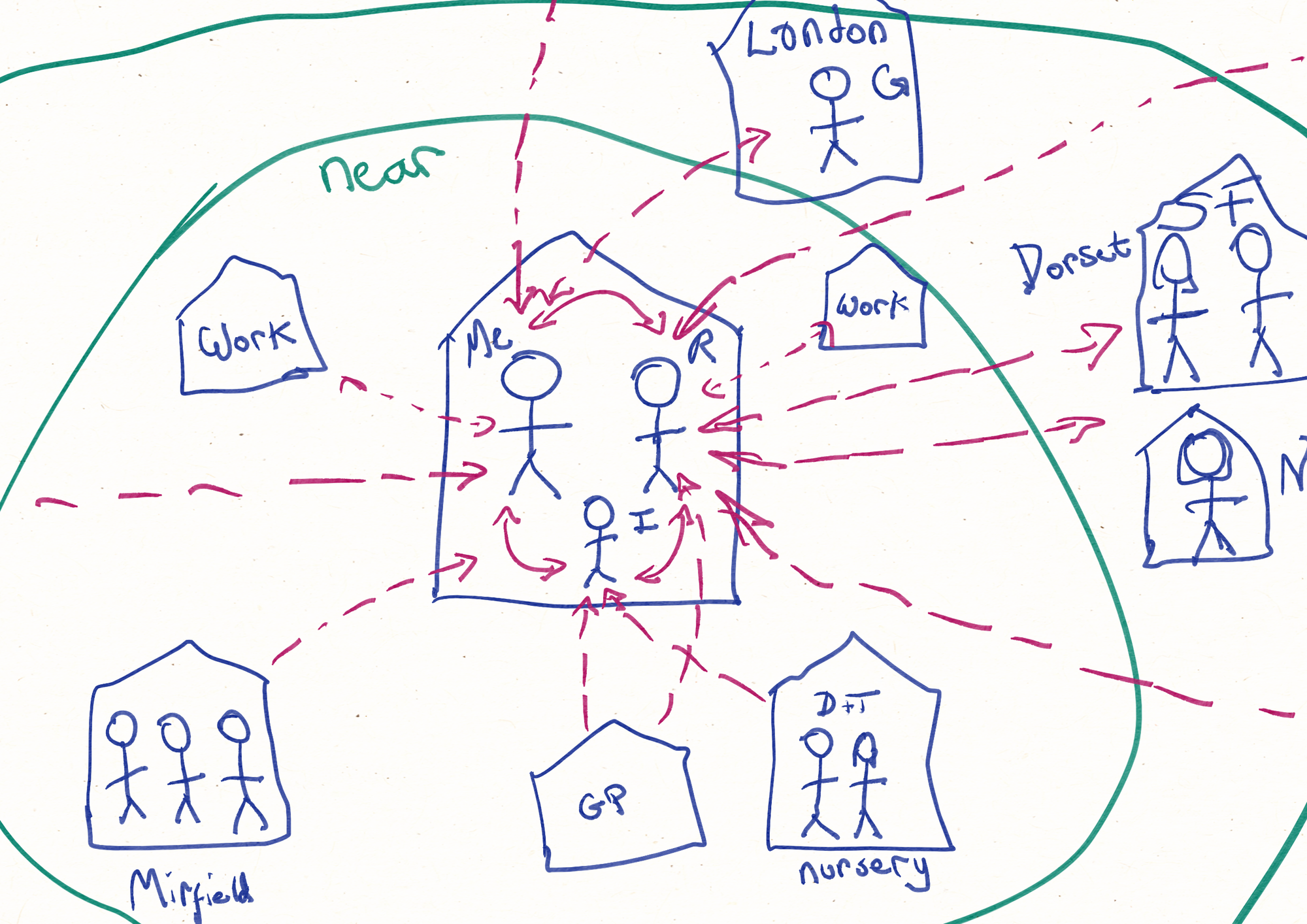Care Mapping: A chat with Amber

Who do you provide care and support for? Who cares for, or supports you? For many, the immediate response to these questions might seem relatively straightforward: a quick roll-call of close family members, maybe a couple of close friends. However like most things in life, the closer you examine these questions the more complex or thought-provoking they become.
Members of Equal Care and the community group Clapton Commons, who work closely with Equal Care’s London Circle, recently attended an online ‘Care Mapping’ workshop. The session was led by Rajiv Mehta, the CEO and founder of Atlas of Caregiving, who talked the attendees through what care mapping entails and the impact it can have.
Amber Wright, the Chair of Equal Care’s Purpose Circle was one of those attendees who attended the workshop and volunteered to share her own experience of the workshop:
Before we move onto what mapping care entails, can you just explain briefly what we might mean by care?
So often we think about care in terms of a designated caregiver: what I, the caregiver, do for the person who needs my help. What this workshop did at the start was remind us that there’s so many ways of thinking about care in your life. It was really helpful how it guided you back to your own life and got you thinking about all of the ways you’ve received care and support from all kinds of people: family, friends, teachers and so on. Care can be many different things.
So in other words, it’s not just about helping people with a thing they can’t do themselves, it’s about other things too: emotional, social and financial support for example.
Yes - it’s about looking at all the interactions and things you receive from others. It leads people, I think, to reflect on aspects of their life that they might feel gratitude for.
It brings in more of that sense of abundance, which is part of what we're trying to do through Equal Care. So many of us are involved in these caring exchanges all of the time and we just don't see it; we don't notice it.
I also think that reflecting on what it feels like to feel cared for in your life, moves you away from that kind of thinking: ‘Right, I’ve just gotta get these tasks done’ and back to the feeling and emotion of it. Although, you know, the immediacy of ‘I just need help to get this stuff done’ is also very real.
So I quite like that aspect of it - asking ‘what is care?’ Turns out it’s all around us, and we don’t always realise.
What is care mapping, if you could describe it briefly?
So fundamentally, care mapping involves thinking about those care relationships you have in your life and making them visual, so starting with you, your home and those people who are nearest to you and then drawing, quite loosely, the other places and people that are there for you in one way or another.
What tools did you need to do this?
Some paper and a pencil: that was it! That worked really well for me: the simplicity of that was great. It was a big part, I think, of why the exercise was so useful for me.
We started with a few thoughts about care, like I’ve said, and some key questions and then were guided through drawing it a bit. We were encouraged to try and do it quickly and not to overthink it. And actually, to do it fast was really interesting: it felt kind of like ‘boom, boom - don’t think about it, just get some stuff down.’ Then afterwards we all sort of stepped back and had a look at who made it onto our pictures.
Why do you think that was interesting?
Well no doubt if I’d taken my time and thought about my picture, I could have filled it out and it would have had more detail. I could have put a lot more on there. But it was suggested to pause at the point where you begin to slow and start considering things more, which was really, really useful. Just looking at my map and thinking, ‘what do I see? What's there? What's not there?’ It prompted questions about what I liked about what was there on my map, what was working well and so on.
I think most people will hopefully find that there’s somebody they can put in on their care map . For many people - particularly those that might feel vulnerable, or lonely, or unable to connect with their community - just the process of putting some of that down, and seeing it visually will undoubtedly help in terms of recognising what is there. And that’s a good place to start from, rather than starting with that feeling of lack.
So is this a tool that you think that a lot of people could use?
Yes definitely: for both personal and community or professional purposes. In fact, there were lots of interesting examples given of how the Atlas Care Mapping tool was being used by different people all over the world. The stories that were shared in the workshop involved people from very diverse backgrounds being shown the tools and in most cases just running with them intuitively, using them for their own particular purposes. I think that’s because of the simplicity of the starting point: some paper and a pen. It’s very empowering to just give people this tool that anyone can use.
I have to say as well that the trainer was great: really experienced and a great advocate of the tool and how it can be used. I’d say that their way of working really sits very well with our own co-op’s values and how we do things.
Was it useful for you personally? Did it make you think about anything?
Yes I think it’s great for reviewing your own situation, your networks, relationships and so on.
I found this helpful personally as I am currently right in the thick of arranging some care in Wales for my sister and her husband, who has dementia.
In terms of its use for Equal Care and its members, how do you think it could benefit us or inform what we do?
I think it could be a really useful technique for us to learn and share within the coop to help people reflect on their care needs and the support they have in their community. We could use it to review where they are at, what is good or not so good and how they would like things to change for the better.
The map is also really good for recognising the reciprocal nature of care relationships and the things that people are already doing to support others in their community, family or neighbourhood which is a big part of the Equal Care model.
------------
To find out more about the Atlas Care Map, visit https://atlascaremap.org/ or https://atlasofcaregiving.com/

